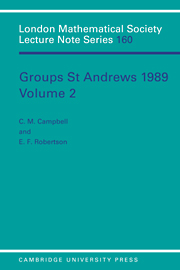Book contents
- Frontmatter
- Contents
- Preface
- Introduction
- 17 A survey of recent results on projective representations of the symmetric groups
- 18 Some applications of graded diagrams in combinatorial group theory
- 19 Rational growth of wreath products
- 20 The modular group and generalized Farey graphs
- 21 On the n-centre of a group
- 22 Existentially closed finitary linear groups
- 23 Permutability and subnormality of subgroups
- 24 Some applications of powerful p-groups
- 25 Combinatorial aspects of finitely generated virtually free groups
- 26 Problems in loop theory for group theorists
- 27 Sylow theory of CC-groups: a survey
- 28 On the minimal number of generators of certain groups
- 29 Lie properties of modular group algebras
- 30 Observations on a conjecture of Hans Zassenhaus
- 31 The Fibonacci groups revisited
- 32 Galois groups
- 33 Infinite simple permutation groups - a survey
- 34 Polynomial 2-cocyles
27 - Sylow theory of CC-groups: a survey
Published online by Cambridge University Press: 13 March 2010
- Frontmatter
- Contents
- Preface
- Introduction
- 17 A survey of recent results on projective representations of the symmetric groups
- 18 Some applications of graded diagrams in combinatorial group theory
- 19 Rational growth of wreath products
- 20 The modular group and generalized Farey graphs
- 21 On the n-centre of a group
- 22 Existentially closed finitary linear groups
- 23 Permutability and subnormality of subgroups
- 24 Some applications of powerful p-groups
- 25 Combinatorial aspects of finitely generated virtually free groups
- 26 Problems in loop theory for group theorists
- 27 Sylow theory of CC-groups: a survey
- 28 On the minimal number of generators of certain groups
- 29 Lie properties of modular group algebras
- 30 Observations on a conjecture of Hans Zassenhaus
- 31 The Fibonacci groups revisited
- 32 Galois groups
- 33 Infinite simple permutation groups - a survey
- 34 Polynomial 2-cocyles
Summary
Introduction
Groups with Černikov conjugacy classes or CC-groups were considered by Polovickn [11] as an extension of the concept of an FC-group, that is, a group in which every element has only a finite number of conjugates. A group G is said to be a CC-group if G/CG(XG) is a Cernikov group for each x ∈ G (see also [12, 4.36]).
In [1] and [7] a classical Sylow theory for CC-groups was initiated. The local conjugacy of the Sylow p-subgroups of a CC-group G was established as was the characterization of when they are conjugate in terms of their number and of internal properties of the group G. We now present a summary of the generalization of the above results to an arbitrary set π of primes. We also consider the usual ingredients of a more complete Sylow theory such as Sylow bases or Carter subgroups, thought of as an extension of the FC-case: see [4], [15], [16], [17] and [18]. The details of the contents of this note can be found in [9] and this, being a survey article, does not contain proofs, except as an illustration.
Throughout our notation is standard and is taken from [12] and [18], to which we refer for the basic definitions and the setting of the problems we are considering. Some parts of the proofs of our results, as we present them here, depend on the interpretation of a residually Černikov group as a co-Černikov group, following the topological approach set out and developed by Dixon [2].
- Type
- Chapter
- Information
- Groups St Andrews 1989 , pp. 400 - 407Publisher: Cambridge University PressPrint publication year: 1991



